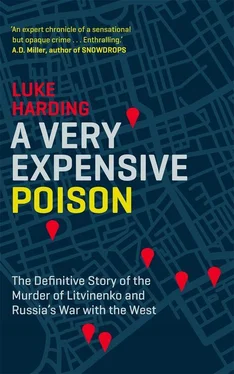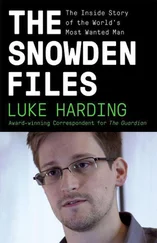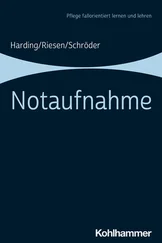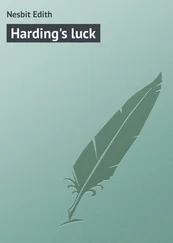The two scientists wearing protective gear gazed at their instruments incredulously. They asked to be withdrawn from the room. The team was stood down on safety grounds.
Amazingly, two months later, detectives located the towels that Lugovoi had chucked away. They had ended up stuck in a laundry chute in the hotel’s basement. A three-foot-by-three-foot metal service tube ran the full height of the building. At its bottom was a mountain of unwashed sheets and towels.
Lugovoi’s bath towel was found in a green laundry bag on a shelf. His hand towel was discovered at the base of the chute.
The levels of radiation were so alarming that the towels were sent to the Atomic Weapons Establishment at Aldermaston, the UK government nuclear facility. The contamination was massive. The bath towel gave a reading of 6,000 counts per second, or 130,000 becquerels per square centimetre. (The unit of radioactivity is named after Henri Becquerel, the French physicist who shared a Nobel prize with Marie and Pierre Curie.)
The most extreme object, though, was Lugovoi’s white hand towel. The initial reading came in as full-scale deflection, greater than 10,000 counts per second. Retested at Aldermaston, it yielded an astonishing result: in excess of 17 million becquerels per square centimetre. To give an idea of context, the equivalent of 10–30 million becquerels absorbed into an adult male’s blood would be likely to be fatal within one month.
The towel was the single most radioactive object recovered by Scotland Yard during its decade-long inquiry. Probably the most radioactive towel in history.
4
The German Waiter
Hamburg, Germany, 1996–2006
‘I have a very expensive poison’
DMITRY KOVTUN TO HIS FRIEND D3 IN HAMBURG, 30 OCTOBER 2006
Dmitry Kovtun had big dreams. Dreams of a better life in the west, of a well-paying job, of a successful career. One day the fantasy took the shape of a vodka factory. Kovtun would be the owner. The factory would be based in Moscow. It would produce vodka with a new and revolutionary type of seal! Another dream was rather more saucy. Kovtun would star in movies. Not just any old movies: specifically, porn movies, with Kovtun playing the role of the stud. Or soft-core magazines. The sex industry would bring him cash, lots of it, maybe fame as well.
Somehow, though, reality never quite matched up to Kovtun’s expectations of it. For him, at least, it was a disappointment. The glamorous career never quite materialised. He didn’t get the breaks. The same could not be said for his silver-tongued friend Andrei Lugovoi. Everything Lugovoi touched turned to gold. But perhaps some of Lugovoi’s good fortune might rub off on him?
Kovtun first met Lugovoi in 1978 or 1979. The boys grew up in the same building where his family and Lugovoi’s family had been granted flats at the same time. ‘Our fathers were friends and worked together at the army general HQ of the USSR armed forces,’ Kovtun said. ‘We were pupils at different schools – I am one year older than Lugovoi – but we spent a great deal of time together as children, visited each other, exchanged books.’
The two families had a shared military story. Kovtun’s father Vadim was a high-ranking officer. (His mother, who lives in Moscow, is a vet.) Lugovoi’s family had a record stretching back to the 1905 Russo-Japanese war. Lugovoi’s father was a colonel in the Soviet army; his grandfather fought with the Red Army against the Nazis in the battle for Berlin in 1945. A brother worked on Russian nuclear submarines. Lugovoi would make much of this patriotic tradition.
It was inevitable that Kovtun and Lugovoi would don uniforms too. In 1982, Kovtun joined an elite Soviet military command academy in Moscow; Lugovoi followed the next year. ‘We saw each other regularly and associated on friendly terms while studying there,’ Kovtun said. He was trained as an engineer for wheeled and tracked vehicles; a practical course took him to Murmansk oblast in Russia’s frozen north; a few old snaps show him there in the sub-arctic.
In 1986, Kovtun graduated as second lieutenant. He was sent to Czechoslovakia and then to Parchim, a town with a large Soviet airfield surrounded by the countryside and forests of Mecklenburg-Vorpommern, in East Germany. Times were changing, though. Back home, Mikhail Gorbachev was trying to reform a tottering USSR. Lugovoi had stayed in Moscow and got a job as a Kremlin bodyguard with the KGB’s ninth directorate. As ever, his assignment was starrier than Kovtun’s.
When the Berlin Wall came down Kovtun was stuck in Parchim, seemingly on the wrong side of history as the communist bloc fell apart. In 1990, he began dating a Russian girl from home, Inne Hohne; they’d met at a Moscow hotel while he was back on leave. In 1991, they married in Russia. Inne, together with her young daughter from a previous relationship, moved with Kovtun to East Germany.
Two months later, Kovtun’s unit received bad news. He and his comrades were being transferred back to Russia’s Caucasus. The north Caucasus was the most explosive corner of what was now the new Russian Federation: the scene of wars and skirmishes between Russian troops and a restive Muslim population since the time of the young Tolstoy and the early years of the nineteenth century. (Three years later, in 1994, Boris Yeltsin pulled the trigger on what would become the first Chechen War.)
Inne told her husband she wasn’t going to Chechnya. She wanted to stay in Germany. Kovtun didn’t fancy fighting either. They came up with a plan. He would desert! They would escape together to West Germany and claim political asylum there. They would start a new life.
Escaping the Russian base turned out to be simple. According to Inne: ‘We packed our things one night and crept out of the barracks, through the fence.’ They took a taxi to Hamburg, driving through the dark. They spent the night at a police station. The next morning they were taken to the aliens’ department. About twenty-five officers from the same Soviet military group also ran away from military camp, though at different times.
Back in Russia, the authorities started criminal proceedings against Kovtun for desertion.
The Germans accepted Kovtun’s asylum claim and placed him temporarily on a boat in Hamburg. Germany’s second biggest city was a temple of post-war prosperity, with a port, a proud mercantilist tradition and a laidback and cosmopolitan sensibility more British than German. It was in Hamburg that John le Carré – then a British intelligence officer – wrote the novel that made him famous, The Spy Who Came in from the Cold . Kovtun and his wife found themselves living in an asylum seekers’ hostel in Blankenese, an affluent district in the west of the city, with large villas, some of them overlooking the right bank of the Elbe.
The hostel was in Björnsonweg, a quiet suburban street named after Norway’s national bard, Bjørnstjerne Bjørnson. It passes an old municipal waterworks – there’s a sign in art deco letters – and ends in a small forest. According to neighbours there were two hostels here, one home to Africans, the other to asylum seekers from the Middle East and elsewhere. (The street was well-named: as well as being a poet and playwright, Bjørnson was a public intellectual involved in the struggle for freedom of expression and against racism.)
Kovtun had made it to the west but his marriage didn’t survive the transition. According to Inne, Dmitry was a feckless husband. He had, she said, a major drink problem.
Contacted by German police in 2006 out of the blue, a decade and a half after severing all ties with Kovtun, Inne Hohne paints a singularly unflattering picture of her first husband. Their marriage was brief, she said, and something of a disaster. At the beginning of 1992, they split because of what she called his ‘escalating drunkenness’.
Читать дальше












